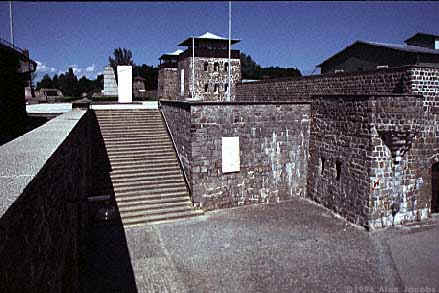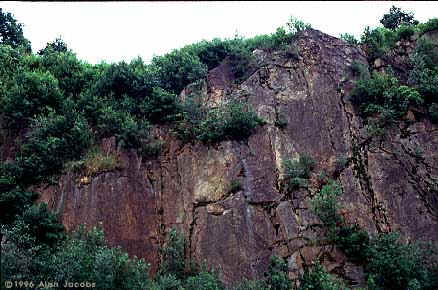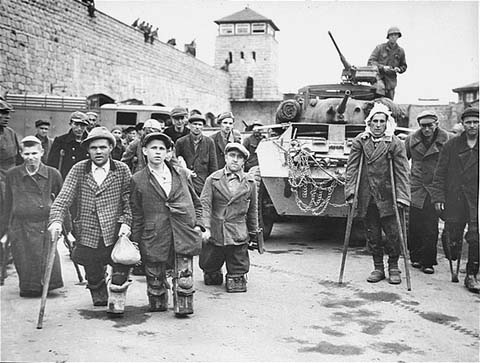| When the first hundred prisoners arrived at Mauthausen,
they were sold to a rock quarry known as " Wiener Graben".
There,
they were forced to construct a granite-fortress prison for the main
camp. Later on, Mauthausen was known as the "Mother Camp" of all
Austria. When Mauthausen was first becoming a camp, it was built according
to the "Dauchau Model" and followed the method of treating prisoners
very poorly. |

|
|
| Mauthausen was located almost 12 miles southeast of Linz, Austria,
Hitler's hometown when he was a teenager. Just a little south of the main
camp of Mauthausen was a hospital camp called the "Russian
Camp", it was used to hold Soviet prisoners of war. On the opposite
side of the hospital camp was a camp called the "Tent Camp".
Here, there were 16 tents put up in the fall of 1944. They were made to
hold the large groups of incoming Hungarian Jews. All of these
smaller parts of the camp and the main camp were surrounded by
electrified fence. |
| |
| The central camp of Mauthausen consisted of 32 barracks.
When these barracks became over-filled, the commander, Franz Zieris,
ordered the surrounding fields be enclosed with barbed-wire fence.
This is where many Hungarian Jews and Russian prisoners stayed out in the
open all year round. This is one reason why Mauthausen was known as a
category three camp which was the worst of the three categories. For the prisoners, a category three camp meant "return not desired" and
"exterminated by labor". Beside the outer wall of the camp,
there were a few stone buildings that served as a kitchen, showers, and
places where laundry was done. The gas chamber, the place where they were
burned, and the camp prison were also among these stone buildings.
Mauthausen's largest sub camp was called Gusen (KZ Gusen) , Gusen was built
only miles outside of Mauthausen. It was almost as gruesome as Mauthausen.
Gusen had two sub camps that were settled later on. Gusen II (St.
Goergen) and Gusen III (Lungitz). The conditions at these two other camps were so bad that the prisoners called them "The Hell of Hell" |
| Prisoners at mauthausen were used as forced labor and
often
died. During the time in which the war was going on, forced labor was
important to German armaments production. Most prisoners at Mauthausen
went through a system in which the Nazi's picked out the ones that were
too weak or ill to perform extreme labor, they were then exterminated.
There were many ways an inmate could die, such as being shot, being
hanged, beaten, starvation, and diseases. But Mauthausen did indeed have a
gas-chamber that could murder 120 inmates per time. Another method of
killing inmates, and one of the SS men's favorite ways, in the winter was
to make inmates get naked. Then the SS men sprayed them with cold water
until the prisoners froze to death. They died very easily because the
average temperature was around 10 degrees Celsius. Another method favored
by the SS men, was throwing inmates off the edge of the rock
quarry. This was a way where inmates were killed very cheaply. The place
where most prisoners jumped was called "The Parachutist's
Wall". Another way than inmates were killed cheaply was by heart
injections. 420 Jewish children from 4 to 7 were murdered in this
way. Also another way y which inmates were killed painfully was by
showering in the winters, and starvation. An average working day for prisoners started
at 4:45 A.M.(5:15 A.M. in the winter), and ended at 7:00P.M. Most of the
ways prisoners were painful but a way that was almost to unbearable but
mostly used for punishment was by "Hanging Inmates In The
Trees". The inmates were taken to a tree and hung by their arms
behind their backs. Most times they Most of the time they were
forgotten and died only 30 minutes later. "Bathing inmates to
Death" was a cruel way to murder inmates. In this technique, 40 to 200
prisoners were taken the showers, here S.S. men exposed them to ice cold
water. This method was created by Karl Chielewski. Not many but a few
prisoners were drowned in huge tubs. Also many prisoners were forced to
walk up 186 carrying while
holding 100 pounds on their backs, and if one person dropped theirs it
would roll back down hitting many people. |
 |
| Some of the expiments that occurred
at
Mauthausen were performed by Dr. Kaminski. But between the years of 1940
and 1944 absolutely no medical assistance was given to Jews and Russian
prisoners, so they were forced to use paper as bandages. There were seven
blocks where medical experiments took place, Bock 26, 27, 28, 29,30, 31,
and 32.
|
| |
| Between 1940 and 1942 many inmates weighed
about 90 pounds. But some other inmates might have weighed only 60 to 80,
and the average time of survival at Mauthausen was about six months. Many
of these prisoners were from the Spanish Republican Army, because they
were defeated by General Franco's Fascist Forces, they fled into France,
and when Great Britain And France went to war with Germany, many Spanish men fought on France's
side. So when France surrendered to Germany, they
were taken prisoners.
|
| |
|

|
In 1945, Mauthausen
became overcrowded and many were dead by the time US forces, under the
command of Colonel Robert R.
Seibel, came to liberate Mauthausen. At that time S.S. men had fled and
left the local people in charge. But the locals wanted to surrender as
quickly as possible. Mauthausen had been operational for seven years. Not
long after Mauthausen was liberated, Sergant Abert J. Kosiek and his
troops liberated the three camp at Gusen. 37,000 had died there.
|
|
|
|
| Of the 200,000 prisoners that passed through
Mauthausen's gates 119,000 died along with 38,120 Jews. For the Mauthausen
trial 58 defendants were fond guilty and recived "The Death Sentence
and three received "Life In Prison".
|
| |
| Eva was born in
Mauthausen on April 29, 1945.
She and her mother were the only to survive in the family of 15.Another
well known survivor of Mauthausen is Mike Jacobs. He was a jew from a
small town in Polland called Konin. He is the founder of the Dallas
Memorial Center for Holocaust studies. An exhibit at this memorial center
has Mike's very own striped hat he says has been " soaked in blood
and sweat where I use to be beaten......" . He know lives in Dallas,
TX. Martin Gilbert, a liberator of Mauthausen remembers a survivor from
the central camp named Sidney Fahn, who had been broght from the
Auchuwitz-Birkenau camp and had only weighed 80 pounds. He remembers that
she was so weak that he couldn't even
greet the US liberators.Another man who survived Mauthausen is Leon
Zelman. He is a journalist that was born in 1928. He is the co-founder of
The Jewish Welcome Service in 1978, that helped jews return to
Austria after they were forced to leave in 1928 by the Nazis in 1928. a
politician that survived Mathausen is Leopold Figl. He is the co-founder
of the Austrian Peoples Party or OVP in 1945. During 1959 he became First
President of the Nationalrat. Also 1962 and 1965 he was the Governor of
Lower Austria. Another survivor of
Mauthausen is Captin J. D. Pletcher. He remembers the odor at
Guskirchen, a subcamp to Mauthausen. " The smell " he says
" nauseated many of the people who went there. It was a smell I will
never forget, completely different from anything I have ever encoutered,
it could almost be seen and hung over the camp like a fog of death.
|
|
| Mauthausen was
very bad and killed many people just for being a different race or being a
prisoner. It also changed many peoples lives very drastically. It was
known so well because it was the biggest camp in Austria. Mauthausen was a
camp that focused most of it's energy on it's reasonably large rock
quarry.
|